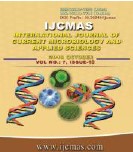


 National Academy of Agricultural Sciences (NAAS)
National Academy of Agricultural Sciences (NAAS)

|
PRINT ISSN : 2319-7692
Online ISSN : 2319-7706 Issues : 12 per year Publisher : Excellent Publishers Email : editorijcmas@gmail.com / submit@ijcmas.com Editor-in-chief: Dr.M.Prakash Index Copernicus ICV 2018: 95.39 NAAS RATING 2020: 5.38 |
We studied the microbiological quality and prevalence of Vibrio parahaemolyticus in finfish and shellfish sold in the domestic markets of West Bengal, India following enrichment in alkaline peptone water and further plating on to thiosulfate citrate bile salt sucrose agar. Total plate count of bacteria in shrimp flesh with the exoskeleton, and finfish muscle with skin was also estimated which ranged from 20±1.12 x 105cfu/g to 73±1.12 x 105cfu/g, and from 0.2 ±0.18 x 105cfu/g to 1.2 ±0.43 x 105cfu/g, respectively. Prevalence of V. parahaemolyticus varied in different fish and shellfish species, with highest prevalence in Lutjanus sp (27.77%) and lowest in Setipinnaphasa (10%); the bacterium was not detected in Labeobata and Channastriata. The contamination rate was higher in shellfish like Penaeus monodon (42.85%) and P. indicus (40%).Contamination was higher during summer than in winter: an average of 20.85 % of finfish and shellfish were contaminated during winter, compared to contamination of 31.45% of samples during summer months. The study showed that although overall microbial load was within permissible limits, fish and shellfish were contaminated with V. parahaemolyticus raising food safety concern to the domestic consumers.
 |
 |
 |
 |
 |